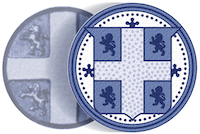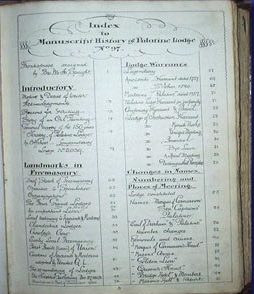Introduction
Written and compiled by W Bro C H M Culkin, PPJGW, PM in the Lodge.
At our 250th Anniversary Meeting held on 11th January 2007 in the Wearside Masonic Temple, Burdon Road, Sunderland, WBro J E Laidler, PM, PAGDC, PPJGW delivered this Introduction to an assembly of distinguished brethren, ably assisted by W Bro J K Bates, PPGReg, PM of Vedra Lodge No 3137.
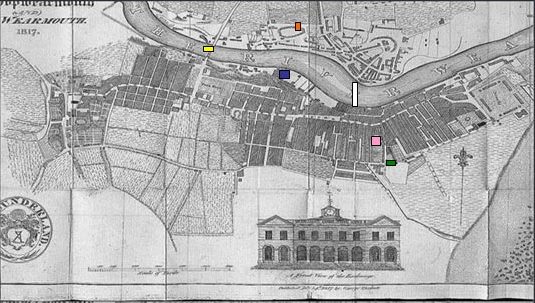
The Bridge (Yellow); St Peter’s Church (Red); Crowley’s Ironworks (Blue); Ferry Crossing (White); Queen St. (Pink); Parish Church (Green)
PLAN OF SUNDERLAND
This plan of Sunderland, dated 1817, depicts very clearly the town as it would have been at the turn of the 18th Century and shows items of interest such as Phoenix Hall, the Barracks there to defend the port and town from French attack, the old town moor and importantly the unique cast iron bridge built by Rowland Burdon.
The history of this lodge covers a period of 250 years – a quarter of a Millennium!
The 250th Anniversary Committee set up to plan and organise the many facets of the celebrations to be held on 11th January 2007 felt that it would be desirable to have a full history of the lodge compiled in order to properly mark this important milestone in our long history.
When the lodge was constituted in January 1757 the identification of all lodges on the Roll of the Grand Lodge of England was by a number only and the number 218 was given to this lodge.
It was known locally as the Marquis of Carnarvon Lodge No 218 until 1768 when the name was changed to Sea Captains’ lodge, reflecting no doubt the nature of the membership.
The lodge was consecrated on 14th January 1757 by W Bro John Thornhill, Worshipful Master and eminent member of the lodge now known as Phoenix Lodge No 94, which itself had been consecrated just about 14 months previously, on 25th November 1755!
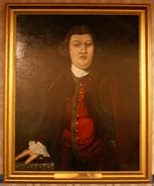
W Bro John Thornhill,
(Reproduction of this painting by courtesy of the artist Christopher O’Neill Walton)
How did it come about that the small Port of Sunderland was able to produce two Moderns warranted lodges in such a short space of time?
The answer may well lie in the fact that a Quaker from the Midlands, Ambrose Crowley, decided to build an Ironworks in Low Street, Sunderland in 1682 principally to make nails which were in great demand for shipbuilding.
For this purpose he brought skilled Catholic ironworkers from Liege and surrounding areas to teach Sunderland men their skills, undoubtedly these men were Hammermen Guild members.
After Crowley had left Sunderland around 1690, and as time went by, a Time Immemorial lodge came into being in Sunderland probably about 1730 but definitely no later than 1745.
The rest of this pre-history is contained in the Preface to the History that you may wish to read afterwards.
The official chronicling of the history of this ancient lodge started when the Secretary, W Bro E G Watson, was given the task of compiling the history of the first 150 years existence of the lodge, this to be ready for the celebration in January 1907.
He succeeded in his task and produced Volume One, 594 handwritten pages on parchment with numerous illustrations and images – a masterful achievement produced by a scholarly and thoughtful man.
W Bro Watson divided his history into 19 different sections: -
|
|
In the book’s index these sections were subdivided into numerous items, each with its individual page number so that the reader could reasonably find the topic, which was of interest to him by using this simple but effective means.
His wish was that his Volume of history should be passed into the keeping of each Worshipful Master at his installation and this wish has been honoured for the past 100 years.
Unfortunately the result has been that not many eyes have been privileged to see it but it has survived in excellent condition, perhaps waiting for this technological age to come along, to open its contents to the view of many more masons and non-masons than Bro Watson would ever have dreamed of.
Visualising that 21st century candidates will be more at home in freemasonry with 21st century technology and that flat screen displays will soon be the norm, it was decided to digitally photograph each of the 594 pages and to place the results on a compact disc. This initially to be used by lodge members as a permanent and easily accessible source of their ancient history and from which extracts can be taken to compile lectures etc.
Under the section ‘Landmarks in Freemasonry’ you will find on page 25 this statement made by W Bro Watson who lived on the north side of the river and close to St Peter’s Church:
From time immemorial Freemasons were a body of Operative workmen, actually engaged in the construction of Public Edifices.
Their introduction into England dates from about 674 AD when Benedict Biscop brought from the continent, to assist in the erection and decoration of the Monastery at Monkwearmouth; Painters, Glaziers, Freemasons and Singers, and from that date many buildings were erected by men in companies, who were called 'Free' because they were at liberty to work in any part of England.
St Peter’s Church, which has been largely reconstructed in modern times, still exists today on the north side of the River Wear. It stands in landscaped grounds and is surrounded by modern University buildings with the National Glass Centre appropriately, just a short distance away.
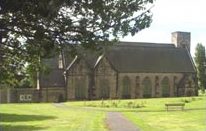
St Peter’s Church, Monkwearmouth, Sunderland, England.
16th September 2006
Ambrose Crowley’s Ironworks was constructed on the opposite side to the Church and just a few hundred yards or so upriver, a point of interest, which we refer to in the Preface. Unfortunately the Ironworks was demolished in 1918.
The first Master of the lodge was a William Scollay who was in office for 4 years, John Henderson followed him, again for a 4 year term and then came the 20 year reign (1765 to 1784) of John Biss of whom the writer and publisher Bro George Garbutt said; -
|
|
|
Indeed the depression was so bad that the lodge came near to dissolution but the cloud started to lift after this period of 7 years or so when on 13th October 1791 Mr Michael Scarth, a candidate for Freemasonry, was Initiated, Passed and Raised into Sea Captains’ Lodge No 144 in the King’s Head Hotel, High Street, Sunderland near the Sea. The publican Hays being his proposer and Rowland Burdon was Master.
1766 - 1805
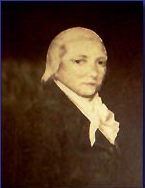
Bro Michael Scarth
Worshipful Master 1792
It would appear that Bro Scarth was rather unusual; a man quick to action, a very able administrator and undoubtedly a leader of men, for just two months after his initiation Bro Scarth was appointed Treasurer of the Lodge and immediately put forward the proposal that a committee of 5 members be appointed to examine the By-laws and Accounts.
The Committee was appointed and he was one of the 5.
The By-laws were quickly drafted and approved and in a short period of time presented to the Lodge by Bro Scarth, not printed but handwritten, contained in a handsomely bound book which all of the brethren then signed. By December 1792, a little over a year since he was initiated into the Lodge, he became Master.
Let the author of the History of Sunderland (1819) Bro George Garbutt, a member of this lodge give his assessment of Bro Michael Scarth:
It was however, destined that as the energy of one man (Biss) had brought the society into a state of reputation and prosperity, and as his loss had occasioned languor, and almost dissolution, so the exertions of another valuable individual, should raise the drooping spirits, restore the accustomed vigour, and infuse light and spirit into all the future proceedings.
In the year 1791 the late Michael Scarth, Esq. became a member of the lodge.
To a mind well informed, and a sound judgment, he joined a facility of application and steady perseverance that would not easily abandon a design, while any advantage could be procured to it, or indeed, while the minutest part of it appeared unaccomplished.
As soon as he was elected to an office, he resolved to use his influence and exertions, to raise the lodge to its former level.
He commenced by improving the rules and By-laws of the society, for which purpose, he visited the different lodges in the neighbourhood; consulted their various regulations, and from them, compiled and composed a code, adapted to secure every fraternal and scientific purpose of the institution.
His other exertions were equally judicious and beneficial; the lodge flourished, and masonry was promoted and respected.
He was perhaps, the greatest master the lodge has ever had, for he quickly recognised that the lodge needed specific aims such as universal charity, education for needy children etc and that it needed the direction and the authority to achieve those aims – he crafted the By-laws to ensure that this happened.
The restructuring of the aims and policies of the lodge, influenced by Michael Scarth, continued at the General Lodge meeting held on 12th April 1792 when it was declared that only those listed and numbered were members of the lodge and no other whomsoever, having forfeited their rights by the 25th Article.
The Lodge was purged of those members who, for whatever reason, were found wanting in the standards expected of them.
Scarth also founded the Royal Arch Chapter of Strict Benevolence No 97 in 1797 but unfortunately he died of typhus fever in 1805 at the age of 39.
Moving now into the 19th century the first prominent Worshipful Master’s name to appear is that of Thomas Hardy, a Woollen Draper by trade, who first occupied the Master’s Chair in 1802 but re occupied it on many occasions thereafter.
He was a member for 60 years and occupied every office in the lodge and served for almost 30 years as ‘Installing Master’; he attained the rank of Prov SGW.
W Bro Sir Cuthbert Sharp presented a Gold Snuff Box to W Bro Thomas Hardy on Dec 27th 1834.
At the banquet the Earl of Durham, ProvGM, said of W Bro Hardy:
I have never met so good a Mason in all my life
This Snuff Box is a great treasure of Palatine Lodge and at one time was given into the care of each W M at his Installation together with W Bro Watson’s Volume 1.
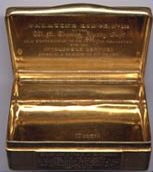
The Gold Snuff Box
It was made and engraved by Walkers of Sunderland
In 1816 Sir Robert Peat, D. D. was elected but not installed as Master– but more on Sir Robert in Volume 3!
Sir Cuthbert Sharp was master of the lodge in 1827. He was captured by the French in the Napoleonic wars but after 4 years escaped and returned to England. He was very active in charitable works especially for those who had suffered at the hands of the French but essentially he was a writer and scholar of great repute and a great friend of Robert Surtees and of Bro Sir Walter Scott.
On one occasion, a while after Sir Walter had visited Sea Captains’ Lodge, Sir Cuthbert wrote to him asking had he remembered that evening. Sir Walter promptly wrote back:
Forget thee? No! My worthy frere!
Forget blithe mirth and gallant cheer?
Death sooner stretch me on my bier
Forget thee? No!Forget the Universal Shout
When “canny S’land spoke out?
A truth, which knaves affect to doubt
Forget thee? No.
On 27th December 1829, the Rt W ProvGM stated that it would be his constant theme to hold the lodge up for example to all the lodges in the Province as a “Pattern and Guiding Star in Masonry”
11th March 1830- “On the proposition of BroThomas Hutchinson, the Worshipful Master, the name of the lodge was changed to “Palatine” in pursuance of a suggestion of the Earl of Durham, Rt W PGM and with the unanimous consent of the Brethren”
Sir Hedworth Williamson, 7th Baronet was WM in 1835 and on two other occasions. He and his sons were connected with Palatine Lodge for a great number of years.
In 1842 Sir Hedworth fought a duel, at noon, with a political opponent a Mr Braddyll, at the sign of the Hare and Hounds in Sedgefield – they both fired twice and missed each other, after which Sir Hedworth apologised for his mistaken remark and shook hands.
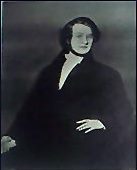
W Bro Alderman Richard Spoor
In the same year on the 14th May the famous ‘Cotton Ball’ duel was fought on Whitburn cliffs between Alderman Spoor, (WM in 1830 and 1831) and a Mr Wright, an attorney who had written a letter to Lord Londonderry reflecting on Alderman Spoor’s character and unfortunately that noble Lord had read it in the House of Lords.
The pistols were filled with cotton balls and consequently no one was hurt.
This event and the reason why cotton balls were used is immortalised in poetic song and can
be found in Volume 1 (Stories).
The era just described could be thought of as a golden era for Palatine Lodge, in many respects, but because of the rapid influx of Irish and Scottish migrant workers in the early part of the 19th century many of the well to do citizens moved west leaving previously good dwellings to turn into overcrowded slums; diseases such as airborne typhus and cholera were rampant, culminating in the 1831 cholera epidemic in which Bro Dr William Reid Clanny, a member of this lodge, took such a major part.
In many instances the Inns in which the lodge held their meetings were no better than common lodging houses and unfortunately the Palatine members’ dream of building their own temple did not materialise.
However, in 1870 St John’s Lodge No 80 invited other lodges of Sunderland to utilise their new temple at Park Terrace, Sunderland and Palatine Lodge moved into the luxury of a purpose built temple with separate dining room and other modern facilities – luxury indeed!!
130 years or so later the façade of the Park Terrace Temple building was saved from being demolished literally in the nick of time due to the forethought of the Provincial Grand Lodge of Durham. It was taken apart bit by bit, rebuilt at Beamish Museum as part of the Millennium Project of the Province and with the addition of a replica working temple Beamish 2000 has become one of the star attractions of the Museum.
In 1934 the then Secretary of the Lodge, W Bro George E Pearson had started to update the history from where W Bro Watson had left off in 1907.
He proceeded with his” labour of love" in a new Volume 2 to the year1937. This consists of 293 pages of handwritten text, on parchment, together with many photographs.
His preferred methodology was to proceed from 1907 year by year, detailing personal and Masonic aspects of each succeeding Worshipful Master and highlighting notable or interesting events during their year in office.
He felt that this method would be helpful in keeping the history updated.
In the late 1920s it became apparent that Park Terrace was too small to accommodate the number of Lodges and members in Sunderland and so in 1932 the Wearside Masonic Temple was opened, due in great part to the untiring efforts of W Bro James Hall. PAGDC, PPGW, a member of this lodge.
Like W Bro Watson, W Bro Pearson gave an assurance that his information came only from the minute books and authentic sources.
As with Volume 1 of the history the contents of Volume 2 were digitised and copied onto a CD.
W Bro Con Culkin, PProvJGW, a PM in the lodge, was asked by the lodge’s 250th Anniversary Committee to update the history of the lodge from 1937 to the year 2007, and to compile a full 250-year history of the lodge.
He decided that as there was a 70 year period to update he would divide it into 10 year segments and that he would use as little text as possible but rather utilise digitally copied extracts from the minute books such as summonses, letters, newspaper cuttings etc which would tend to better portray the feeling of the times.
During the course of compiling Volume 3 several other invaluable books: Fines Books, Accounts, and the original By- Laws presented to the lodge by Bro Scarth were examined and recorded. A magnificent Minute book dated 1791 to 1794 in which is recorded, among other items, the original lodge details of the procession to lay the foundation stone for Rowland Burdon’s Iron Bridge was also recorded.
The original was presented by the lodge members to W Bro Rowland Burdon
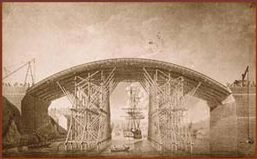
Ironbridge Gorge Museum
Courtesy of the Museum’s Trust
ELTON COLLECTION
All of these extra items have been copied and digitised and have their special place in this Volume 3. He also undertook to photograph and digitise Volumes 1and 2 and place the data on to CDs as described above.
Care has been taken to try to keep the authenticity and character of Volumes 1 and 2 as near to their initial compilation as possible so that the reader may properly appreciate the era and the conditions they were produced in.
With the three separate histories digitised it only remained to link them together so that they could be read as one and lastly they were all connected to the World Wide Web.
We hope that masons and non-masons alike will appreciate this Palatine Lodge history, which has been compiled faithfully from the minute books and other authentic sources by our own members over the last 100 years. It is long and detailed and we hope that all visitors may find something of particular, or general, interest to themselves and that it may come to be regarded as a valuable reference for members of this lodge and students of freemasonry.
Acknowledgements
I particularly wish to acknowledge the generous help and support given to me by W Bro Jack Thompson, PM, PPJGW when compiling this ancient history. His knowledge of the records and artefacts of this lodge has been gained by his ‘hands on’ care of them over a period of many years.
I gratefully acknowledge the help and assistance of Bro Martin R Lawson, Junior Deacon of Mowbray Lodge No 5373 whose unselfish use of his professional IT knowledge and design flair has enabled this wonderful history to be portrayed in the best possible manner to a worldwide audience. (Martin is now W Bro Lawson, and was instrumental in helping Con create our first Lodge website, where this, and all previous history articles, were first made publically available).
Grateful thanks to W Bro T F R Coulson, PAGDC, Curator of the Provincial Grand Lodge of Durham’s Museum and Library who was most helpful and supportive and W Bro R N Neville, PAGDC for his continuous help and encouragement since starting me on this 250 year journey.
W Bro C H M Culkin, PPJGW, PM in the lodge.
(Author of the History of Chapter of Strict Benevolence No 97)
